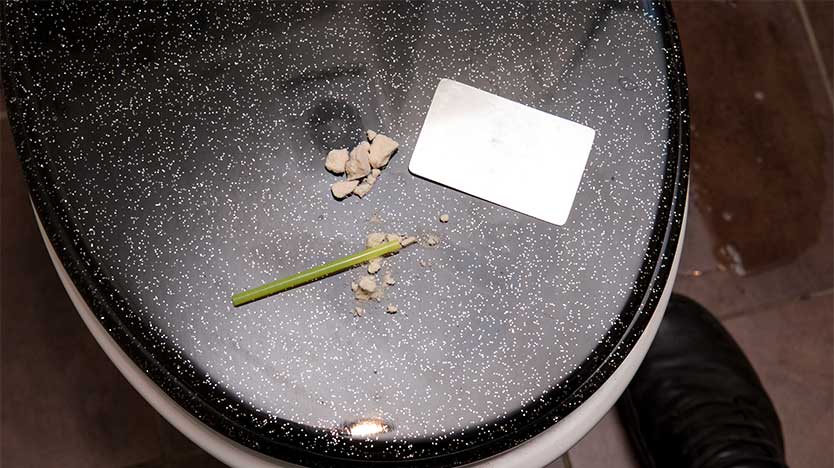Crack Addiction | Crack Cocaine In Ohio

Medically Reviewed By: Kimberly Langdon, M.D.
Addiction can affect people differently, but many of the telltale signs are the same. Noticing these signs early may be the key to addressing the problem before it ruins someone’s life.

Crack is a smokeable form of cocaine. About 657,000 people used crack in 2020, and 1.3 million people who abused cocaine in any form had a cocaine use disorder. Crack has no medical purpose, and abusing it can lead to long-term health effects, overdose, and addiction.
Facts About Crack
Crack is commonly referred to as “freebase” cocaine because of the process used to make it. Powdered cocaine is made of cocaine hydrochloride, while crack is cocaine separated from hydrochloride (the base is free from the acid).
Here are a few facts about crack:
You Can Make Crack With Baking Soda
You can make crack by heating cocaine powder with baking soda or ammonia. It makes a crackling sound while heating and results in rock-like crystals. Though it contains impurities, crack is popular because it has a much lower melting point than cocaine hydrochloride.
True freebase cocaine used to be made with ammonia and ether. But since ether is highly flammable, this process was dangerous and is rarely used today.
Crack Is A Stimulant
Crack cocaine is a stimulant drug. Its effects are similar to those of amphetamines (Adderall) or methamphetamine. It speeds up your heart rate, breathing, and brain activity, giving you a rush of energy, focus, and euphoria.
But the effects are short-lived. The high from crack only lasts five to 10 minutes.
Crack Is Highly Addictive
When you smoke crack, it has an immediate and intense effect. This pleasurable sensation makes you more likely to take the drug again. Since the high wears off quickly, many people take repeated hits to keep it going.
Research indicates that crack is the most addictive form of cocaine because of its brief effect and the tendency to binge. The drug is classified as a schedule II controlled substance as it has a high potential to be abused and is likely to cause addiction.
Effects Of Crack
Crack cocaine produces a high by preventing the brain from reabsorbing dopamine, so there’s extra dopamine floating around. Dopamine is a hormone that’s part of the brain’s reward system. It makes you feel good when you do something positive, like exercise.
Some effects of crack abuse are:
- euphoria (extreme happiness)
- increased energy
- mental alertness
- irritability
- mood swings
- hypersensitivity to sight, sound, and touch
- paranoia (unreasonable distrust of others)
According to the National Institute on Drug Abuse (NIDA), “large amounts of cocaine can lead to bizarre, unpredictable, and violent behavior.” If you smoke a lot of crack at once or take overlapping doses, you could lose control.
Risks Of Crack Abuse
Since there’s no medical use for crack cocaine, abusing it is dangerous and damaging to your health. Risks of crack abuse include overdose, long-term health effects, and addiction.
Crack Overdose
Taking too much crack cocaine at once can cause an overdose on crack. You can also overdose if you take overlapping doses that introduce more crack into your body before it’s had a chance to metabolize the last dose.
Mixing crack with other stimulants raises the risk of overdose that may result in a heart attack or death. Combining it with a depressant (such as opioids, alcohol, or benzodiazepines) makes it hard to tell when you’ve had enough.
Long-Term Health Effects
Crack cocaine abuse can cause many health problems—especially concerning your heart. Chest pain is a common complaint that sends many people who use crack to the emergency room each year. Rapid heart rate and heart attack are other risks.
Smoking crack can also damage the lungs, causing:
- a persistent cough
- new or worsened asthma
- respiratory distress (difficulty breathing properly)
- a higher risk of lung infections like pneumonia
Sharing a broken crack pipe can spread bloodborne diseases like HIV and Hepatitis C if a broken pipe comes in contact with open lip sores.
Other long-term health effects associated with crack cocaine abuse are:
- loss of appetite, weight loss, and malnutrition
- a weak immune system
- raised body temperature
- high blood pressure
- muscle twitches
- blisters on lips or fingers
- the sensation of bugs crawling on or under the skin(“coke bugs”)
- movement disorders, such as Parkinson’s disease
- hallucinations
- severe paranoia
- psychosis
Crack Addiction In Ohio
Some people think they can try crack just once, and it will be fine. Then they take one more hit because the high wears off so quickly, and then one more. Before they know it, they’re having cravings they can’t resist.
When you get the reward of excess dopamine from crack cocaine use, it reinforces drug-taking behavior. The more you depend on crack to feel good, the more addicted you become.
Signs Of Crack Addiction
Addiction can affect people differently, but many of the telltale signs are the same. Noticing these signs early may be the key to addressing the problem before it ruins someone’s life.
Some common signs of crack addiction are:
- secretive behavior
- loss of interest in hobbies
- strained relationships with family and friends
- money problems from buying drugs
- crack paraphernalia (like thin glass or metal pipes)
- difficulty maintaining a job or good grades
- noticeable changes in health-related to crack abuse
- increased energy or restlessness
You may also be able to tell if someone is addicted to crack if they go without it. Though crack doesn’t cause physical dependence, an addicted person may have a hard time hiding symptoms of withdrawal like depression, fatigue, slow thinking, or insomnia.
Crack Addiction Treatment In Ohio
The most effective crack addiction treatment programs combine evidence-based therapies and work with you to create a unique treatment plan.
Crack treatment options often include:
- Detoxification (detox) programs for crack cocaine offer support as you go through the withdrawal process to rid your body of crack so you can focus on recovery.
- Support groups place you with other people who have abused crack so you can share your experiences and encourage each other.
- Cognitive-behavioral therapy helps you reframe your negative thought patterns to produce healthier behavioral choices and positive coping techniques.
- Family therapy encourages family members to repair broken relationships and restore trust so they can support their loved one’s recovery.
- Exercise heals your body and mind, produces dopamine naturally, and gives you a healthy outlet for stress management.
- Yoga and meditation center your mind and spirit while strengthening your body.
Some treatment facilities offer dual diagnosis treatment, which addresses co-occurring mental disorders. Often, the symptoms of another mental problem get worse with addiction, are the cause of substance abuse, or both. Resolving both issues at once ensures a better chance of avoiding relapse.
At Ohio Recovery Center, we offer residential rehab programs for crack cocaine addiction. Many people benefit from an inpatient environment during early recovery. It removes them from the stresses of everyday life and provides 24-hour support.
Our personalized treatment programs help you regain your physical and mental health, give you the tools to prevent relapse, and teach you how to live without crack cocaine.
Contact a treatment specialist to learn more and start healing today.
FAQs
How Long Does Crack Stay In Your Urine?
Crack stays in your urine for up to 2 days after the last use. The length of time crack cocaine stays in urine may depend on a variety of factors.
Learn more about How Long Crack Cocaine Stays In Your System
What Happens When You Snort Crack?
When a person snorts crack cocaine, they immediately experience a “rush” of euphoria. However, snorting crack can lead to serious health problems such as damage to your nasal passageways, nosebleeds, and other health concerns.
Learn more about Snorting Crack Cocaine
What’s The Difference Between Freebasing & Smoking Crack?
Freebasing refers to any method used to increase the potency and achieve the purest form of cocaine. Freebase forms of cocaine may not include crack cocaine, which is a specific type of cocaine that takes the form of a rock crystal.
Learn more about Freebasing Cocaine Vs. Smoking Crack
How Much Does Crack Cost On The Street?
In Ohio, crack cocaine usually costs between $60 to $100 per gram. The specific price depends on the drug’s purity. In general, the less pure it is, the cheaper it is.
Crack cocaine also tends to cost less for Ohioans who live in big cities. That’s because cities typically have higher supplies of crack cocaine, and higher supplies often lead to lower prices.
Learn more about Crack Cocaine Street Prices In Ohio
When Was The U.S. Crack Epidemic?
The United States crack epidemic began in the early 1980s and lasted until the early 1990s. The crack epidemic was a public health crisis that was linked to an uptick in violent crime.
Inner-city black communities may have been disproportionately affected by crack cocaine use and the subsequent policies against it.
Learn more about the U.S. Crack Epidemic
What Does Crack Look Like?
In contrast with powder cocaine, crack cocaine looks like uneven solid clumps in a yellow or off-white color. This color and texture can vary considerably depending on what other substances have been cut into crack cocaine rocks.
Learn more about What Crack Looks Like
Can You Identify Crack By Smell?
You can identify crack by smell when it’s lit, heated, or actively being smoked. Smoking crack can often smell like burning plastic, cleaning chemicals, or sulfuric acid.
Learn more about What Crack Cocaine Smells Like
What Does Fake Crack Look Like?
Fake crack has a similar appearance to real crack, which can prove to be hazardous for those purchasing drugs from street dealers. Fake crack has the appearance of “rocks,” just as real crack, and may contain bath salts or synthetic cathinones.
Learn more about Fake Crack Cocaine
What Is Crack Called On The Street?
Crack cocaine is known by several nicknames on the street such as black rock, nuggets, jelly beans, freebase, scotty, boulder, ice cubes, and more.
Learn more about Crack Cocaine Street Names
- Britannica - Cocaine https://www.britannica.com/science/cocaine#ref278101
- National Institute on Drug Abuse - Cocaine DrugFacts https://nida.nih.gov/publications/drugfacts/cocaine
- Substance Abuse and Mental Health Services Administration - Key Substance Use and Mental Health Indicators in the United States: Results from the 2020 National Survey on Drug Use and Health https://www.samhsa.gov/data/sites/default/files/reports/rpt35325/NSDUHFFRPDFWHTMLFiles2020/2020NSDUHFFR1PDFW102121.pdf
- US Drug Enforcement Administration - Drug Scheduling https://www.dea.gov/drug-information/drug-scheduling

